

China Buys Into Multiple Warheads. After exercising restraint in its nuclear weapons program for decades, China has made the poor choice of upgrading its arsenal in a way that raises concerns about its intentions, introduces new uncertainty in Asia and could add more fuel to a regional arms race.

The unsettling development is China’s decision to equip its most powerful missile — the DF-5 for Dong Feng or East Wind, which can reach the United States — with multiple warheads instead of just one. The information was reported publicly for the first time earlier this month in the annual Pentagon report on China’s military and security programs. Chinese military develops new anti-tank missile. Russia signals nod to sale of S-400 anti-aircraft missile to China|Politics|News|WantChinaTimes.com. China's land-based missile interception test successful. They Shoot Satellites, Don't They? Look, I understand if you missed it, what with all the missiles flying around these days.

But China conducted another missile defense test in late July. Even for a terse statement clocking in at a mere 64 words, the official announcement by the Chinese Ministry of Defense is marvelous for how little it says. Let me try to convince you that it is worth about 2,800 words of wonky exegesis. I promise, it's worth it. China Has Begun Limited Fielding of New Antiship Ballistic Missile: DOD.
PrintShareEmailTwitterFacebookLinkedIn By Rachel Oswald Global Security Newswire WASHINGTON -- China has begun initial deployment of a new ballistic missile capable of attacking U.S. aircraft carriers, according to a Pentagon assessment released on Monday.
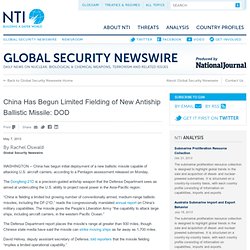
The Dongfeng-21D is a precision-guided antiship weapon that the Defense Department sees as aimed at undercutting the U.S. ability to project naval power in the Asia-Pacific region. “China is fielding a limited but growing number of conventionally armed, medium-range ballistic missiles, including the DF-21D,” reads the congressionally mandated annual report on China’s military capabilities. The Defense Department report places the missile’s range at greater than 930 miles, though Chinese state media have said the missile can strike moving ships as far away as 1,700 miles. David Helvey, deputy assistant secretary of Defense, told reporters that the missile fielding “implies a limited operational capability.”
China to launch its first solid fuel rocket before 2016. China plans to launch its first solid fuel rocket by 2016, marking a strategic shift from liquid fuel rockets, which so far has been used in over 170 successful launches in the last two decades.
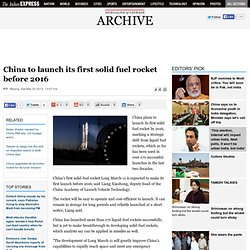
China's first solid-fuel rocket Long March-11 is expected to make its first launch before 2016, said Liang Xiaohong, deputy head of the China Academy of Launch Vehicle Technology. The rocket will be easy to operate and cost-efficient to launch. It can remain in storage for long periods and reliably launched at a short notice, Liang said. China has launched more than 170 liquid-fuel rockets successfully, but is yet to make breakthrough in developing solid-fuel rockets, which analysts say can be applied in missiles as well. "The development of Long March-11 will greatly improve China's capabilities to rapidly reach space and meet any emergency launching demand in case of disasters and emergencies," Liang told state-run Xinhua news agency. Please read our terms of use before posting comments. China’s Bulava? » FAS Strategic Security Blog. DF-21D Anti-Ship Ballistic Missile (ASBM) ; the carrier killer.
New York Times: Distorting Chinese Press Report on Missile Capabilities? Controversy over missile test comes during U.S.- China military talks.

New York Times journalist Keith Bradsher published a story on August 24 that contained the following statement: “The Global Times, a newspaper directly controlled by the Chinese Communist Party, reported Wednesday that China was developing the capability to put multiple warheads on intercontinental ballistic missiles, or ICBMs.” Mr. Bradsher’s language, especially the phrase noting that the Global Times is “directly controlled by the Chinese Communist Party,” strongly suggests that the report China was developing a new ICBM capable of carrying multiple warheads was a statement of fact authorized by the Chinese government.
I was unable to find a Global Times report that justifies this suggestion. Mr. In other words, the report that China was “developing” the capability to put multiple warheads on ICBMs originally came from Bill Gertz, was repeated by Jane’s Defense Weekly and was repeated again by the Global Times. Gregory Kulacki: Misattribution and Exaggeration Mar Reporting on Chinese Missile Test. China is reported to have conducted a missile test during the latter part of July.
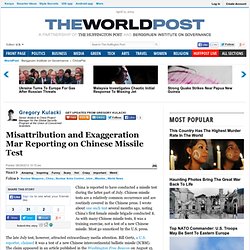
Chinese missile tests are a relatively common occurrence and are routinely covered in the Chinese press. I wrote about one such test several months ago, noting China's first female missile brigade conducted it. As with many Chinese missile tests, it was a training exercise, not a test of a new Chinese missile. DF-21C Missile Deploys to Central China » FAS Strategic Security Blog. .
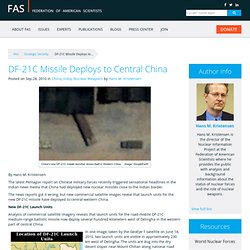
By Hans M. Kristensen The latest Pentagon report on Chinese military forces recently triggered sensational headlines in the Indian news media that China had deployed new nuclear missiles close to the Indian border. The news reports got it wrong, but new commercial satellite images reveal that launch units for the new DF-21C missile have deployed to central-western China. New DF-21C Launch Units Analysis of commercial satellite imagery reveals that launch units for the road-mobile DF-21C medium-range ballistic missile now deploy several hundred kilometers west of Delingha in the western part of central China. In one image, taken by the GeoEye-1 satellite on June 14, 2010, two launch units are visible in approximately 230 km west of Delingha. The eastern launch unit (38° 6’37.75″N, 94°59’2.19″E) includes a central area with red barracks clearly visible below the camouflage, which probably also covers logistic units such as communications vehicles, fuel trucks, and personnel carriers.
Chinese Missiles Could Destroy Most U.S. Outposts in Asia, Report Finds. China has the ability to decimate five of the United States' six military outposts in Asia with repeated missile assaults, according to an annual congressional report on Chinese-U.S. ties released today (see GSN, Oct. 7).

China's Evolution on Ballistic Missile Defense. China’s approach toward ballistic missile defense is shifting.
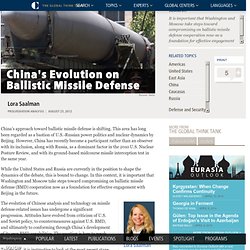
This area has long been regarded as a bastion of U.S. -Russian power politics and nuclear dynamics by Beijing. However, China has recently become a participant rather than an observer with its inclusion, along with Russia, as a dominant factor in the 2010 U.S. Nuclear Posture Review, and with its ground-based midcourse missile interception test in the same year. While the United States and Russia are currently in the position to shape the dynamics of the debate, this is bound to change.
The evolution of Chinese analysis and technology on missile defense-related issues has undergone a significant progression. To this end, it is instructive to look at the most recent stage of this evolution. First, the number of strategic and technical articles on missile defense has increased exponentially within Chinese databases over the past decade, offering some of the greatest transparency available on any given security-related issue.